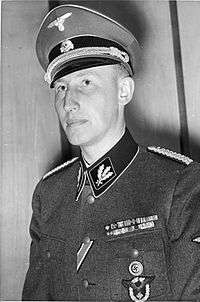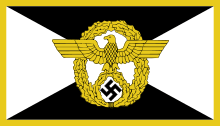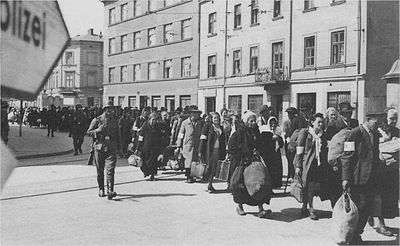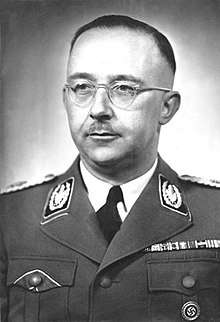Reich Main Security Office
The Reich Main Security Office[lower-alpha 1] (German: Reichssicherheitshauptamt or RSHA) was an organization subordinate to Heinrich Himmler in his dual capacity as Chef der Deutschen Polizei (Chief of German Police) and Reichsführer-SS, the head of the Nazi Party's Schutzstaffel (SS). The organization's stated duty was to fight all "enemies of the Reich" inside and outside the borders of Nazi Germany.
| Reichssicherheitshauptamt (RSHA) | |
| RSHA overview | |
|---|---|
| Formed | 27 September 1939 |
| Preceding agencies |
|
| Dissolved | 8 May 1945 |
| Type | • Secret police • Intelligence agency |
| Jurisdiction | |
| Headquarters | Prinz-Albrecht-Straße 8, Berlin 52°30′26″N 13°22′57″E |
| Employees | 50,648 (c. February 1944)[1] |
| Minister responsible |
|
| RSHA executives |
|
| Parent RSHA | Ministry of the Interior (nominally) |
| Child agencies |
|
Formation
Himmler established the RSHA on 27 September 1939. Himmler's assumption of total control over all security and police forces in Germany was the "crucial precondition" for the establishment and growth of the Nazi state.[2] He combined the Nazi Party's Sicherheitsdienst (SD; SS intelligence service) with the Sicherheitspolizei (SiPo; "Security Police"), which was nominally under the Interior Ministry. The SiPo was composed of two sub-departments, the Geheime Staatspolizei (Gestapo; "Secret State Police") and the Kriminalpolizei (Kripo; "Criminal Police").[3] The RSHA was often abbreviated to RSi-H[4] in correspondence to avoid confusion with the SS-Rasse- und Siedlungshauptamt (RuSHA; "SS Race and Settlement Office").
The creation of the RSHA represented the formalization, at the top level, of the relationship under which the SD served as the intelligence agency for the security police. A similar coordination existed in the local offices. Within Germany and areas which were incorporated within the Reich for the purpose of civil administration, local offices of the Gestapo, criminal police, and SD were formally separate. They were subject to coordination by inspectors of the security police and SD on the staffs of the local higher SS and police leaders, however, and one of the principal functions of the local SD units was to serve as the intelligence agency for the local Gestapo units. In the occupied territories, the formal relationship between local units of the Gestapo, criminal police, and SD was slightly closer.[5]
Throughout the course of wartime expansion, the RSHA continued to grow at an enormous rate and was "repeatedly reorganized".[6] Routine reorganization did not change the tendency for centralization within the Third Reich nor did it change the general trend for organizations like the RSHA to develop direct relationships to Hitler, adhering to a familiar National Socialist pattern of the leader-follower construct.[7] For the RSHA, its centrality within Nazi Germany was pronounced since departments like the Gestapo (within the RSHA) were controlled by Himmler and his immediate subordinate SS-Obergruppenführer and General of Police Reinhard Heydrich; they held the power of life and death for nearly every German and were essentially above the law.[8]

Heydrich remained the RSHA chief until his assassination in 1942. In January 1943 Himmler delegated the office to SS-Obergruppenführer and General of Police Ernst Kaltenbrunner, who headed the RSHA until the end of World War II in Europe.[9] The head of the RSHA was also known as the CSSD or Chef der Sicherheitspolizei und des SD (Chief of the Security Police and of the Security Service).[10][11]
Organization
According to British author Gerald Reitlinger, the RSHA "became a typical overblown bureaucracy... The complexity of RSHA was unequalled... with at least a hundred... sub-sub-sections, a modest camouflage of the fact that it handled the progressive extermination which Hitler planned for the ten million Jews of Europe".[12]
The organization at its simplest was divided into seven offices (Ämter):[13][14]
- Amt I, "Administration and Legal", originally headed by SS-Gruppenführer Dr. Werner Best.[11] In 1940, he was succeeded by SS-Brigadeführer Bruno Streckenbach. In April 1944, Erich Ehrlinger took over as department chief.
- Amt II, "Ideological Investigation", headed by SS-Brigadeführer Professor Franz Six.[11]
- Amt III, "Spheres of German Life" or the Inland-SD, headed by SS-Gruppenführer Otto Ohlendorf, was the SS information gathering service for inside Germany.[11] It also dealt with ethnic Germans outside of Germany's prewar borders, and matters of culture.
- Amt IV, "Suppression of Opposition", formed from Abteilung II and III of the Gestapa (better-known by the "sobriquet" Gestapo),[15] headed by SS-Gruppenführer Heinrich Müller.[16] SS-Obersturmbannführer Adolf Eichmann, one of the main architects of the Holocaust, was head of the Amt IV sub-department called Referat IV B4.[17]
- Amt V, "Suppression of Crime" Kriminalpolizei (Kripo), originally led by SS-Gruppenführer Arthur Nebe[18] and later by SS-Oberführer Friedrich Panzinger.[19] This was the Criminal Police, which dealt with non-political serious crimes, such as rape, murder, and arson. Amt V was also known as the Reichskriminalpolizeiamt (Reich Criminal Police Department or RKPA).
- Amt VI, "Foreign Intelligence Service" or Ausland-SD, originally led by SS-Brigadeführer Heinz Jost[18] and later by SS-Brigadeführer Walter Schellenberg.
- Amt VII, "Ideological Research and Evaluation" was a reconstitution of Amt II overseen by SS-Brigadeführer Professor Dr. Franz Six.[20] Later it was headed by SS-Obersturmbannführer Paul Dittel. It was responsible for "ideological" tasks. These included the creation of anti-semitic, anti-masonic propaganda, the sounding of public opinion and monitoring of Nazi indoctrination by the public.
Leadership

| No. | Chief of SiPo and SD | Took office | Left office | Time in office | |
|---|---|---|---|---|---|
| 1 | SS-Obergruppenführer Reinhard Heydrich (1904–1942) | 27 September 1939 | 4 June 1942 † | 2 years, 250 days | |
| – | Reichsführer-SS Heinrich Himmler (1900–1945) Acting | 4 June 1942 | 30 January 1943 | 240 days | |
| 2 | SS-Obergruppenführer Ernst Kaltenbrunner (1903–1946) | 30 January 1943 | 12 May 1945 | 2 years, 102 days |
Role in the Holocaust
The RSHA controlled the security services of Nazi Germany and the Nazi Party (NSDAP). Its activities included intelligence-gathering, criminal investigation, overseeing foreigners, monitoring public opinion, and Nazi indoctrination. The RSHA was also "the central office for the extra-judicial NS (National Socialist) measures of terror and repression from the beginning of the war until 1945".[21] The list of "enemies" included Jews, Communists, Freemasons, pacifists, and Christian activists.[22] In addition to dealing with identified enemies, the RSHA advocated expansionist policies for the Reich and the Germanization of additional territory through settlement.[23] Generalplan Ost (General Plan East), which was the secret Nazi plan to colonize Central and Eastern Europe exclusively with Germans, displacing inhabitants in the process through genocide and ethnic cleansing in order to obtain sufficient Lebensraum, stemmed from officials in the RSHA, among other Nazi organizations [24].
According to German historian, Klaus Hildebrand, the RSHA was "particularly concerned with racial matters".[25] Adolf Eichmann stated in 1937 that "the anger of the people expressed in riots [was] the most effective means to rob the Jews of a sense of security";[26] although the chaos of rioting was debated within the RHSA, it continued in many places and forms, not monitored, and even encouraged by the RHSA. An order issued by the RSHA on 20 May 1941 overtly demonstrates its utter complicity for the systematic extermination of Jews, namely since the order included instructions to block emigration of any and all Jews attempting to leave Belgium or France as part of the "imminent Final Solution of the Jewish question".[27] Besides blocking emigration, the RSHA, working with Eichmann's Reich Association of Jews in Germany, deliberately deceived Jews still living in Germany and those of other countries by promising them good living quarters, medical care, and food in Theresienstadt (a concentration camp which was a way station to extermination facilities like Auschwitz) if they turned over their assets to the RSHA through a 'phony' home-purchase plan.[28]
The RSHA oversaw the Einsatzgruppen, death squads that were formed under the direction of Heydrich and operated by the SS. Originally part of the SiPo, in September 1939 the operational control of the Einsatzgruppen was taken over by the RSHA. When the units were re-formed prior to the invasion of the Soviet Union in 1941, the men of the Einsatzgruppen were recruited from the SD, Gestapo, Kripo, Orpo, and Waffen-SS.[29] The units followed the invasion forces of the German Army into Eastern Europe. In its role as the national and NSDAP security service, the RSHA coordinated activities among a number of different agencies that had wide-ranging responsibilities within the Reich.[30] Not infrequently, commanders of Einsatzgruppen and Einsatzkommando sub-units were also desk officers from the main office of the RSHA.[31] Historian Raul Hilberg estimates that between 1941 and 1945 the Einsatzgruppen, related agencies, and foreign auxiliary troops co-opted by the Nazis,[lower-alpha 2] killed more than two million people, including 1.3 million Jews.[34]
Part of the RSHA's efforts to encourage other nations (many of whom were occupied by the Germans) to hand over their Jews or entice them into the arms of the Nazis, included coercing them by assigning Jewish advisory officials, all of which was part and parcel to Eichmann's goal of rounding up and transporting "Jews from Slovakia and Hungary, Croatia and Romania".[35] Entry into the Second World War afforded the RSHA the power to act as an intermediary in the areas extended far beyond the Reich, which according to Hans Mommsen, lent itself to solving "emergency situations" and the RSHA's radicalized destructive goals like the Final Solution, were implemented thereupon with bureaucratic methodical cruelty as its power expanded.[36]
Rosenstrasse protest and RSHA involvement
As early as 1941, Propaganda Minister Joseph Goebbels began to complain that large numbers of Jews had not been "evacuated" because of their work in the armaments industry.[37] By late 1942, Hitler and the RSHA were ready to rid Berlin of the German Jews still residing there. Many were married to Aryan Germans and protected by their jobs in armament factories, as the firms deemed these Jewish employees irreplaceable laborers. These Jews believed that these factors ensured their safety.[38] Auschwitz was pushing the government to send more laborers as they struck a deal with the arms producer IG Farben to construct a camp specifically for arms development using slave labor, further supporting Hitler’s decision.[39] In September of 1942, Hitler decided that the protection of armament companies must end and that the Jews must go. As a result, the RSHA decreed the Fabrik-Aktion, an initiative which expressed their intent to "register" all Jews working in these firms; it also stated that the primary targets of this action were those Jews "living in mixed marriages."[38]
The RSHA planned to remove all German Jews from Berlin in early 1943 (the deadline to deport these Jews was 28 February 1943, according to a diary entry Goebbels wrote in early February).[40] On 27 February 1943, the RSHA sent plainclothes Gestapo officials to work, arresting intermarried Jews and charging them with various crimes; anywhere the Gestapo could find Berlin's Jews, they were detained.[41] Around 2,000 intermarried Jewish men were taken to Rosenstrasse 2-4, where they were held.[42] Goebbels complained that many of the arrests had been "thwarted" by industrialists since some 4,000 Jews were expected to be detained.[43] Angry wives began appearing in front of the building on Rosenstrasse to protest—as "Women of German blood" on behalf of their husbands—against this action.[44] On March 6, all but 25 of the intermarried Jews were released; the 25 still held were sent to Auschwitz.[45] The RSHA had failed at quietly rounding up and deporting Jewish men married to German women. On March 8, RSHA head Ernst Kaltenbrunner told Interior Minister Wilhelm Frick that the deportations had been limited to Jews who were not intermarried.[46]

- Display on bus stop at the site of Adolf Eichmann's former office in Berlin at Kurfurstenstrasse 115 (now occupied by a hotel building). After the founding of the RSHA in 1939, Eichmann became director of RSHA sub-section (Referat) IV D 4 (Clearing Activities, or Räumungsangelegenheiten) (1940), and, after March 1941, IV B 4 (Jewish Affairs, or Judenreferat). Both offices organized the deportation of Jews. From this position, Eichmann played a central role in transporting over 1.5 million Jews from all over Europe to Nazi killing centers.[47]
See also
- Glossary of Nazi Germany
- List of SS personnel
- OVRA – Fascist Italy's secret police, similar to the Gestapo
- SS-Wirtschafts-Verwaltungshauptamt (WVHA, the economic & administrative department of the SS)
- Red Orchestra – RSHA operations against a wartime Soviet espionage ring.
Explanatory notes
- The Reichssicherheitshauptamt is variously translated as "Reich Main Security Office", "Reich Security Main Office", "Reich Central Security Main Office", "Reich Security Central Office", "Reich Head Security Office", or "Reich Security Head Office".
- Hilberg outlines the participation of non-German auxiliaries assigned to the Order Police and Einsatzgruppen in these killing operations within his work, Perpetrators, Victims, Bystanders: The Jewish Catastrophe, 1933–1945.[32] He also discusses the overall complicity of non-German governments.[33]
References
Citations
- Nachama 2010, p. 358.
- Broszat 1981, p. 270.
- Longerich 2012, pp. 201, 469, 470.
- McNab 2013, p. 41.
- Avalon Project–Yale University, Judgement: The Accused Organizations.
- Bracher 1970, p. 353.
- Williamson 2002, pp. 34, 35.
- Shirer 1988, pp. 373, 374.
- Rich 1992, p. 49.
- Buchheim 1968, p. 173.
- Höhne 2001, p. 256.
- Reitlinger 1989, p. 138.
- Buchheim 1968, pp. 172–187.
- Weale 2012, pp. 140–144.
- Weale 2012, p. 85.
- Höhne 2001, pp. 256–257.
- USHMM, Adolf Eichmann: Key Dates.
- Höhne 2001, p. 257.
- Friedlander 1997, p. 55.
- Buchheim 1968, p. 174.
- Zentner & Bedürftig 1991, p. 783.
- Longerich 2012, p. 470.
- Mazower 2008, pp. 204–211.
- Dülffer 2009, p. 157.
- Hildebrand 1984, p. 61.
- Stoltzfus 2016, p. 118.
- Bracher 1970, p. 426.
- Bracher 1970, p. 427.
- Longerich 2010, p. 185.
- Jacobsen 1999, p. 86.
- Burleigh 2000, p. 599.
- Hilberg 1992, pp. 87–102.
- Hilberg 1992, pp. 75–86.
- Rhodes 2002, p. 257.
- Bracher 1970, p. 428.
- Mommsen 2000, p. 193.
- Schulle 2009, p. 159.
- Schulle 2009, p. 160.
- Stoltzfus 2016, p. 251.
- Stoltzfus 2016, p. 252.
- Schulle 2009, pp. 160–161.
- Stoltzfus 2016, p. 252, 297.
- Schulle 2009, p. 161.
- Schulle 2009, p. 164.
- Stoltzfus 2016, p. 255–256.
- Stoltzfus 2016, p. 258.
- USHMM, Adolf Eichmann.
Bibliography
- Bracher, Karl Dietrich (1970). The German Dictatorship: The Origins, Structure, and Effects of National Socialism. New York: Praeger. ASIN B001JZ4T16.CS1 maint: ref=harv (link)
- Broszat, Martin (1981). The Hitler State: The Foundation and Development of the Internal Structure of the Third Reich. Harlow: Longmans. ISBN 978-0582489974.CS1 maint: ref=harv (link)
- Buchheim, Hans (1968). "The SS – Instrument of Domination". In Krausnik, Helmut; Buchheim, Hans; Broszat, Martin; Jacobsen, Hans-Adolf (eds.). Anatomy of the SS State. New York: Walker and Company. ISBN 978-0-00211-026-6.CS1 maint: ref=harv (link)
- Burleigh, Michael (2000). The Third Reich: A New History. New York: Hill and Wang. ISBN 978-0-80909-325-0.CS1 maint: ref=harv (link)
- Dülffer, Jost (2009). Nazi Germany 1933–1945: Faith and Annihilation. London: Bloomsbury. ISBN 978-0-34061-393-1.CS1 maint: ref=harv (link)
- Friedlander, Henry (1997). The Origins of Nazi Genocide: From Euthanasia to the Final Solution. Univ of North Carolina Press. ISBN 978-0807846759.CS1 maint: ref=harv (link)
- Hilberg, Raul (1992). Perpetrators, Victims, Bystanders: The Jewish Catastrophe, 1933–1945. New York: Harper Collins. ISBN 0-8419-0910-5.CS1 maint: ref=harv (link)
- Hildebrand, Klaus (1984). The Third Reich. London and New York: Routledge. ISBN 0-0494-3033-5.CS1 maint: ref=harv (link)
- Höhne, Heinz (2001). The Order of the Death’s Head: The Story of Hitler’s SS. New York: Penguin Press. ISBN 978-0-14139-012-3.CS1 maint: ref=harv (link)
- Jacobsen, Hans-Adolf (1999). "The Structure of Nazi Foreign Policy, 1933–1945". In Christian Leitz (ed.). The Third Reich: The Essential Readings. Oxford: Blackwell Publishing. ISBN 978-0-63120-700-9.CS1 maint: ref=harv (link)
- Longerich, Peter (2010). Holocaust: The Nazi Persecution and Murder of the Jews. Oxford; New York: Oxford University Press. ISBN 978-0-19-280436-5.CS1 maint: ref=harv (link)
- Longerich, Peter (2012). Heinrich Himmler: A Life. Oxford: Oxford University Press. ISBN 978-0-19-959232-6.CS1 maint: ref=harv (link)
- Mazower, Mark (2008). Hitler's Empire: How the Nazis Ruled Europe. New York; Toronto: Penguin. ISBN 978-1-59420-188-2.CS1 maint: ref=harv (link)
- McNab, Chris (2013). Hitler's Elite: The SS 1939–45. Osprey. ISBN 978-1-78200-088-4.CS1 maint: ref=harv (link)
- Mommsen, Hans (2000). "Cumulative Radicalization and Self-Destruction of the Nazi Regime". In Neil Gregor (ed.). Nazism. Oxford Readers. Oxford; New York: Oxford University Press. ISBN 978-0-19289-281-2.CS1 maint: ref=harv (link)
- Nachama, Andreas (2010). Topography of Terror: Gestapo, SS and Reich Security Main Office on Wilhelm-and Prinz-Albrecht-Strasse—A Documentation. Berlin: Stiftung Topographie des Terrors. ISBN 978-3-94177-207-6.CS1 maint: ref=harv (link)
- Reitlinger, Gerald (1989). The SS: Alibi of a Nation, 1922–1945. New York: Da Capo Press. ISBN 978-0306803512.CS1 maint: ref=harv (link)
- Rhodes, Richard (2002). Masters of Death: The SS-Einsatzgruppen and the Invention of the Holocaust. New York: Vintage Books. ISBN 0-375-70822-7.CS1 maint: ref=harv (link)
- Rich, Norman (1992). Hitler's War Aims: Ideology, the Nazi State, and the Course of Expansion. New York: W.W. Norton & Co. ISBN 978-0393008029.CS1 maint: ref=harv (link)
- Schulle, Diana (2009). "The Rosenstrasse Protest". In Beate Meyer; Hermann Simon; Chana Schütz (eds.). Jews in Nazi Berlin: From Kristallnacht to Liberation. Chicago and London: The University of Chicago Press. ISBN 978-0-22652-157-2.CS1 maint: ref=harv (link)
- Shirer, William L. (1988) [1961]. The Rise and Fall of the Third Reich. New York: Ballantine Books.CS1 maint: ref=harv (link)
- Stoltzfus, Nathan (2016). Hitler's Compromises: Coercion and Consensus in Nazi Germany. New Haven and London: Yale University Press. ISBN 978-0-300-21750-6.CS1 maint: ref=harv (link)
- Weale, Adrian (2012). Army of Evil: A History of the SS. New York: Caliber Printing. ISBN 978-0451237910.CS1 maint: ref=harv (link)
- Williamson, David G. (2002). The Third Reich (3rd ed.). London: Longman. ISBN 978-0582368835.CS1 maint: ref=harv (link)
- Zentner, Christian; Bedürftig, Friedemann (1991). The Encyclopedia of the Third Reich. (2 vols.) New York: MacMillan Publishing. ISBN 0-02-897500-6.CS1 maint: location (link) CS1 maint: ref=harv (link)
Online
- Avalon Project–Yale University. "Judgement: The Accused Organizations". Retrieved 14 November 2018.
- USHMM. "Adolf Eichmann". United States Holocaust Memorial Museum—Holocaust Encyclopedia. Retrieved 14 November 2018.
- USHMM. "Adolf Eichmann: Key Dates". United States Holocaust Memorial Museum—Holocaust Encyclopedia. Retrieved 14 November 2018.
Further reading
- Evans, Richard J. The Coming of the Third Reich. New York: Penguin, 2005.
- Evans, Richard J. The Third Reich in Power. New York: Penguin, 2006.
- Evans, Richard J. The Third Reich at War. New York: Penguin, 2009 [2008].
- Office of US Chief of Counsel For Prosecution of Axis Criminality, ed. (1946). Nazi Conspiracy and Aggression. Washington, DC: US Government Printing Office. Vol. 1 and Vol. 2.
- Wildt, Michael (2002). Generation of the Unbound: The Leadership Corps of the Reich Security Main Office, Jerusalem: Yad Vashem. ISBN 965-308-162-4.
- Wildt, Michael (2010). An Uncompromising Generation: The Nazi Leadership of the Reich Security Main Office. Madison, WI: University of Wisconsin Press.
- Williams, Max (2001). Reinhard Heydrich: The Biography. Vol. 1 Road To War. Church Stretton: Ulric Publishing. ISBN 978-0-9537577-5-6.CS1 maint: ref=harv (link)
- Williams, Max (2003). Reinhard Heydrich: The Biography. Vol. 2 Enigma. Church Stretton: Ulric Publishing. ISBN 978-0-9537577-6-3.CS1 maint: ref=harv (link)


